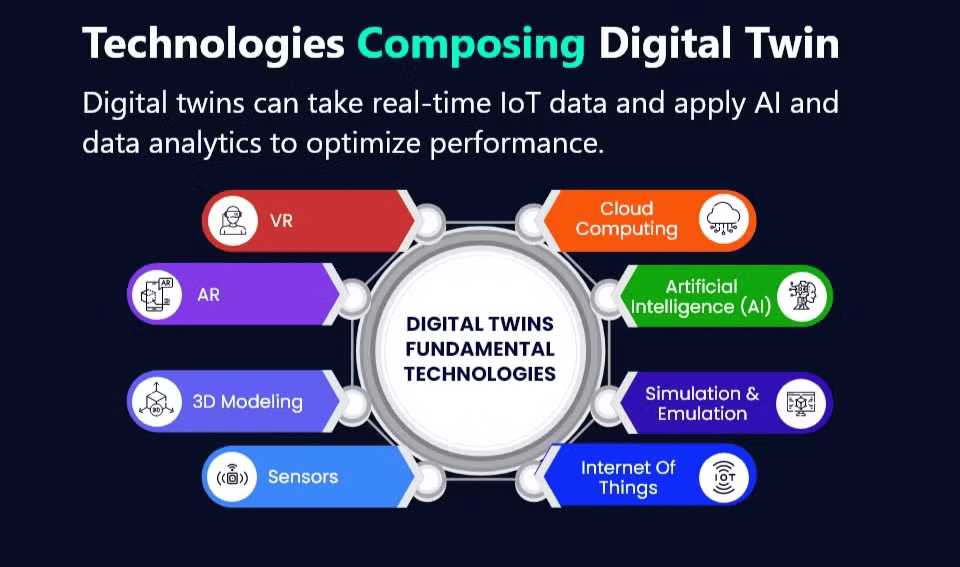pharoscion global
Photographer: pharoscion Copyright: pharoscion Credit: pharoscion
Insights for Manufacturing, Automotive, and Engineering Sectors
Written By : Mudit, Indian Institute of Technology Roorkee

All that we can gather from its name is that its existence is virtual and a twin of something real.
But what exactly is it? A digital map of a place, an AutoCAD design of a product, or something else?
What are the benefits? How does it work?
Let's answer these questions one by one followed by an industry-wise analysis of Digital Twins in the Manufacturing, Automotive, and Engineering industries -
A digital twin is a digital replica of a physical object, system, or process that mirrors its real-world counterpart in real-time. This technology integrates real-time data from sensors, IoT devices, and other sources to create a dynamic model that reflects the current state and behavior of the physical entity. Digital twins are powerful tools for simulation, analysis, and optimization, enabling organizations to predict outcomes, enhance decision-making, and improve operational efficiency. Digital Twins Require a lot of Technological integrations to get proper output. Some of these Fundamental Technologies are given below.


Specifically Manufacturing, automotive, and engineering sectors have extremely complex Operation Chains and Product iterations that require something other than Real-world trial and Error to ensure cost and time-effective processes, This is where the Dynamic, real-time reflecting digital twin models in different parts of the value chain not only helps improve the overall efficiency but also helps handle the time constraints and environment constraints skillfully, proving why it is essential to adapt to digital twins in these industries.
There are several types of digital twins:
In sectors like aerospace and automotive, companies like Boeing and Tesla use digital twins to improve product design and performance through extensive simulations before physical prototypes are built. Overall, digital twins represent a transformative approach to understanding and optimizing physical systems, driving innovation across various industries.

Given above is an infographic representation of how the workings of a Digital Twin look like.
At its core, digital twinning operates through three main steps:
Hurdles in Application
Despite its benefits, digital twinning comes with challenges:
Despite these hurdles, the benefits of digital twins often make them worthwhile:
In The Engineering Industry :
As Industry 4.0 advances, digital twin technologies are increasingly utilized in engineering and mechatronics to enhance product and system design and development. Coined by NASA in 2010 to describe digital models of spacecraft components, the concept of digital twins has since been widely adopted across various industries. A digital twin provides virtual representations of systems, components, and environments, mirroring physical characteristics and functionality.
Key Benefits of Digital Twin Technology
In summary, digital twins significantly enhance design, efficiency, and reliability, making them invaluable in the modern engineering landscape.
In The Manufacturing Industry :
What is a Digital Twin in Manufacturing?
A digital twin is a virtual replica of a physical object. To expand on this for manufacturing, a digital twin in manufacturing is a virtual replica of a process or system. According to the definitions, a digital twin can range from an HMI graphic screen displaying real-time data of the actual asset to a first principle’s simulation model allowing real-time “what-if” scenario analysis about the asset. The first example is ubiquitous and accomplished quickly and cost effectively. The second, however, is highly specialized and requires a significant amount of effort to implement. Digital twins can be used to mirror a physical manufacturing process or plant. This dynamic and evolving representation enables manufacturers to have a virtual sandbox of their plant. This can be a powerful tool for optimizing performance, predicting maintenance needs, and fostering innovation.
Complementary Technologies:
Digital twin technology is transforming manufacturing by improving operational efficiency and fostering innovation through various applications.
Equipment Monitoring
Training
Tours and Guest Engagement
Design Planning
By integrating digital twins, manufacturers can innovate rapidly, respond effectively to market demands, and promote sustainability, ultimately setting new standards in the industry.
In The Automotive Industry:
Originality is highly important in such a dynamic field as the automotive industry. That is precisely where two promising technologies, namely, simulation and digital twins come into play.
What is Simulation?
Virtual prototyping can be defined as the creation of a computer model of a certain vehicle or part of it in order to evaluate its work in actual conditions. One may picture it as a playpen where engineers can run their minds over their design and the real product they want to create. The prototype is called Simulate.
Now Simulate is a simple form of a digital twin. It is an electronic twin of a tangible automobile or part that always synchronizes new data with the physical entity. This is like an event that is being broadcast in real-time, like watching a life-like simulation.
How Do These Technologies Benefit Automotive Development?
Real-World Examples
Many automotive, manufacturing, and engineering companies are already leveraging these technologies:
Digital twins are driving a new era of operational intelligence across manufacturing, automotive, and engineering sectors. They not only improve efficiency and foster innovation, but also provide a robust framework for strategic, data-driven decisions. Organizations embracing this digital transformation today are poised to lead in their industries tomorrow. As they evolve, digital twins will continue to shape the future of industrial operations, offering unprecedented insights and capabilities.
 McKinsey & Company
Digital Twins: What Could They Do for Your Business
McKinsey & Company
Digital Twins: What Could They Do for Your Business
 Robert Kwiatkowski
Leveraging Digital Twins for Competitive Advantage
Robert Kwiatkowski
Leveraging Digital Twins for Competitive Advantage
 McKinsey & Company
Improving Warehouse Operations Digitally
McKinsey & Company
Improving Warehouse Operations Digitally